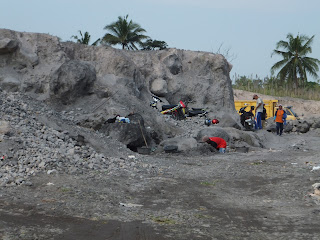Bronggang is a village approximately 15km from Mt. Merapi, and offers a lesson on the importance of preparedness and vigilance in the shadow of an active volcano. The learning that can be gleaned from this site is invaluable, as the eerie alien landscape of a devastated village buried in pyroclastic material stands silently as a memorial of the limits of human preparedness.
1. There were many casualties in the village of Bronggang as the order to evacuate was not given until it was too late (45 killed). According to eye witnesses, the village headman was still at a meeting, discussing if the order of evacuation was to be given.
2. Many people felt that Bronggang would not be affected by the eruption, as there was no historical record of pyroclastic material hitting the locality. The government had also built an evacuation center near the village, leading to many thinking that Bronggang would be a safe place to flee to in the event of an eruption. The psychological impact of perceived safety may have lulled the villagers into complacency.
Currently, there are no plans to restore Bronggang; it is a silent reminder of the limitations of human preparedness. Living in the shadow of Mt. Merapi is indeed a dance with death. However, the deluge of pyroclastic material and subsequent lahar flows has provided ample valuable natural resources for the adjacent village. Fertile soils still provide farming opportunities, and the volcanic sand is plumbed by sand miners.
Ever opportunistic, people who live in the shadow of Mt. Merapi have learnt to find boon in adversity.
The evacuation sign...that did not lead to safety
Sand miners taking a break
House destroyed by pyroclastic fallout
Investigation into nature of deposits: pyroclastic or lahar material
(notice cloud of loose material blown away by the wind: the deposits are still loose, 2 years on)
House partially buried in pyroclast and ash fallout
Interior of a house destroyed by ash fallout
Destroyed house, with partial revegetation visible in middle ground
Extent of damage to houses caused by pyroclastic fallout
Padi fields nourished by volcanic ash deposits
EOS and NIE staff exploring Bronggang
Remains of a tree blasted apart by the extreme heat of the pyroclastic flow
Poignant reminder of the frailty of life










































